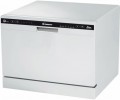Water consumption per cycle
The amount of water used by the machine in one wash cycle. Usually, it is indicated for a standard (universal) programme — at full load, without pre-rinsing, etc. Accordingly, in special modes, the consumption may differ from the indicated one.
The lower the consumption, the better. On the other hand, a reduction in consumption can harm the quality of the wash. So, when choosing an
cost-effective machine, you should pay special attention to the wash class (see below). In addition, only models of the same capacity can be compared in terms of consumption — after all, the more dishes, the more water is required to wash them.
End-of-cycle signal
Signal indicates that the machine has finished working. Many dishwashers are quiet, and without a special signal, it can be difficult to determine if the programme has ended.
Display
The machine has its own
display. Typically, this is the simplest LCD screen capable of displaying multiple characters. However, even such a screen provides additional convenience and makes the operation more intuitive: various notifications can be displayed on it, in particular, about the current operating mode, the remaining time, set timers, the remaining detergent, etc. More advanced dishwashers can be equipped with
a TFT display with advanced features. But this does not affect the washing process.
Noise level
It is an approximate noise level produced by the dishwasher during operation. In modern models, this parameter can range from 38 – 39 dB (muffled human voice) to 59 – 60 dB (rather a loud conversation); more detailed decoding of what sound corresponds to a particular number of decibels can be found in special tables. Anyway, the
low noise level contributes to the comfortable use of the device. It is important if the dishwasher is to be used at night.
Noise class
It allows one to decipher the values of the noise level in decibels. It is marked, like other classes, in Latin letters, where A is the quietest class of dishwashers.

